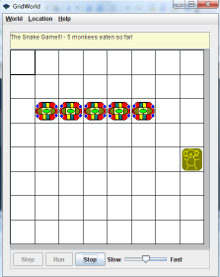Well,
My AP Summer Institute officially wrapped up on Thursday. It was a great week and we covered lots of material and had fun doing it.
I had participants from all over with the furthest coming from Florida. Last year, I had a participant from China which was cool as well. I found out that some of my attendees this year had mad skills, including Senior Olympic archery, Vice-Presidential experience, Athletic Training, CIA experience, Social disturbia ( pretty sure that is the proper description and a pretty common comp sci diagnosis ), Home Improvement, Buried Treasure Hunting, Aerobics, Tennis, Fire Safety, and Computer Science. I list Computer Science last as it just does not stack up against the rest. How could Computer Science compete with Buried Treasure Hunting?
During the workshop, we spent a good deal of time discussing how you could and should use GridWorld all year long when teaching the AP A Course. The case study is very dynamic and makes the course much more fun and engaging for the students. It provides a nice game platform as well.
I also spent tons of time on the basic fundamentals of the AP A course, including ifs, loops, arrays, ArrayList, interfaces, abstract classes, and recursion, but not necessarily in a programming centric way. I tried to present ways to teach the topics that makes them relevant and gives them context to which students can relate. When teaching matrices and interfaces, I teach these topics in the context of Codes and Ciphers to show the students some of the ways Computer Science is used beyond just typing in braces and semi-colons. It works well and I think the workshop participants found the approach effective as well.
Pre/AP was discussed and I included tools like Scratch, Alice, and Jeroo as pre/AP courses do not have to be taught using Java. I spent time showing how you can use Scratch, Alice, and Jeroo to teach any AP level topic effectively. We did some nice list processing in Scratch.
We also spent time discussing ways to broaden participation in Computer Science. Participants visited the ACM Education Policy Committee site to see the resources posted there.
The workshop wrapped up with a look at the new AP Computer Science Principles course that is being developed. Participants visited the AP Computer Science Principles site as well as Dan Garcia’s Full Frontal Nerdity site ( you have to love the name ) to see some of the resources posted for Dan’s new pilot AP CS course.
Lunch everyday was awesome! I am very motivated by food that was a huge plus for sure. It was a great time and I am sad it is over.
I should have taken some pics, but I didn’t so imagine you see people writing code and looking really excited when looking below this line.
(:)(:)(:)~~(:)(:)(:)
(:)(:)(:)~~(:)(:)(:)


